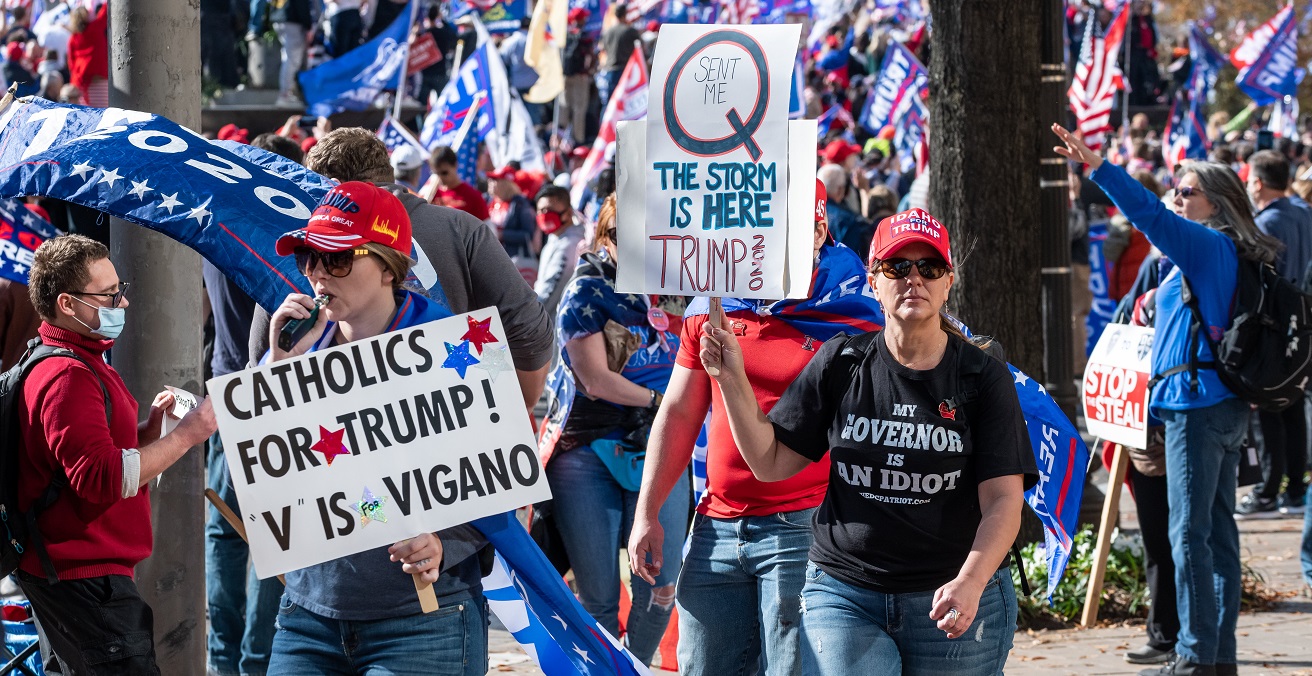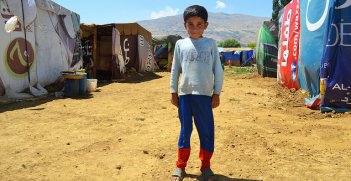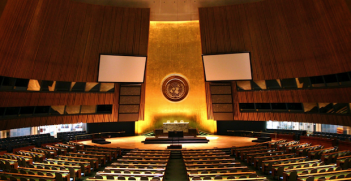ASIO, Sticky Ideologies, and Anti-Government Movements

In recent years, the balance of counter-terrorism discourse has tipped rightwards. But in addressing the problem of reactionary violence, the rise of a strange mix of subcultures with fluid identities has resulted in traditional definitional starting points for understanding ideological extremism being re-evaluated.
The conditions encouraging violence are highly complicated and difficult to comprehend. In efforts to encourage a more rigorous discussion, the Australian Security Intelligence Organisation (ASIO) has provocatively dumped the labels “right-wing” and “Islamic” extremism, aiming to alter the language around problems related to radicalisation, terrorism, and violent extremism.
While delivering his second Annual Threat Assessment in Canberra, ASIO Director-General Mike Burgess stated that ASIO will start reframing these acts as “ideologically motivated violent extremism” and “religiously motivated violent extremism” – two umbrella groupings that aim, in part, to better describe the fact that violent actors can be motivated by multiple ideologies and conspiracies.
A key motivation for this shift in classification was that while extremist actors had previously been grouped into neat (and sometimes misrepresentative in the case of burdening the Muslim community) categories, such intuitive systems of typology had become much more contestable, outmoded, and fluid.
Pejorative Connotations
The term terrorism itself is a social construct and its specific definition has, and will continue to, change within particular social and historical contexts. Terrorism as a tactic can also be considered a composition of a variety of actions undertaken for a wider political or religious purpose.
Terrorist threats do remain a serious challenge, and ASIO has correctly identified new trends exacerbating said threats. The report identified trends within terrorist threats such as changing radicalisation pipelines, the shifting organisational nature of extremist groupings, and the hardening phenomenon of terrorist groupings which blend conspiratorial fears with the ideologies of extremist movements.
As a starting point, such conspiratorial beliefs, providing the foundations for QAnon theory (that initially revolved around Democrat-run centres for paedophiles) can be seen as encouraging paranoia, a blanket distrust of authority, and anti-social behaviour that might incorporate the de-humanisation of vulnerable groups. Indeed, it has been argued that the COVID-19 pandemic has played a significant role in popularising the cult-like QAnon movement. While the movement originated in the US, it has since witnessed an adaptive transnational global spread, finding deep footholds, for instance, within pockets of the Australian community.
Transnational reassessments
The ASIO re-assessment of language does closely mirror a re-thinking of labels within equivalent overseas counter-parts, including in both Canada and the US.
On March 2 at a Senate Judiciary Committee hearing, FBI Director Christopher Wray testified that terrorism has been “metastasizing” into “blended ideologies.” Wray explained that “One of the things that we struggle with… is that more and more the ideologies … that are motivating some of these violent extremists are less and less coherent…. And in some cases it seems like people [are] coming up with their own sort of customized belief systems … maybe combined with some personal grievance.’’
In other words, not only can a range of extremist ideologies overlap, but the merging of such shared rhetoric, while possibly grounded in advancing a common tactic (e.g. domestic terrorists who wish to advance anti-Semitic attacks), in isolation might be seen as contradictory or even totally incompatible. Alternatively, the Anti-Defamation League (ADL) recognised how, in dealing with anti-government ideology and individuals who might be cherry-picking motivations from numerous extremist factions. A report pointed to the transplant and interchange of opposing ideologies and how extremists can reflect both incohesive worldviews and unstable identities. .Similarly, the harmful conspiratorial thinking of the QAnon moment has not been not solely restricted to the “political right.” There is evidence that tenants of QAnon that reject expert or authoritative information have found their way into the wellness community, and have been embraced by “new age” influencers who may not identify as members of the QAnon community. Additionally, the growth of emerging heterogeneous radical citizenship hubs often operate outside traditional and established channels of political and civic participation. The modern-day Sovereign Citizen movement – that believe they are not bound to obey law and governments are fraudulent corporate entities – is a decentralised movement that is not tied to a single alliance and cuts across ideological spectrums comprised of individuals who do not have a simple demographic or geographic profile.
Ideological amalgamation
Labor MP Ed Husic suggested the term “right-wing” extremism has been sidelined to placate policymakers wishing to avoid the “ugly streak” within conservatism. But the Australian Intelligence Community (AIC) does not appear to be blind in the right eye. ASIO is devoting more resources to dealing with the growing threat of extreme right-wing domestic terrorism and white supremacist ideologies. Burgess also indicated that, while a preference remained to refer to threats in “nationalistic” or “racist” terms, ASIO could continue to use the term “extreme right-wing” when relevant. This was evident in a recent consideration when the far-right white-supremacist organisation – the UK-based Sonnenkrieg Division – was listed as a terrorist group for the first time.
When addressing a smorgasbord of individual grievances, radicalisation does remain a cluttered social, non-linear, and multifaceted process. There is no single terrorist profile. Patterns of violence are not always comparable and can be based on an assemblage of personal and political issues. Many extremist groups also continue to maintain highly decentralised structures.
Notably, extremist ideas today do cross-pollinate, especially online, and intermingle with other “distinct” groupings that might incorporate or co-opt beliefs such as the illegitimacy of governments or hierarchies of superiority. Race crimes by white supremacists can go hand in hand with other tactical inspirations like misogyny. Another example can be seen in the popularity of what was initially seen as a politically motivated pro-Trump movement in QAnon, which has split into adaptive groupings in which some strands embrace a distinctly evangelical flavour in their language and often apocalyptic speculations.
In short, multiple different motivations can underpin violent individual actions. Various reactive elements of extremist ecosystems are increasingly gravitating towards a common culture of hate or intolerance or grievance or denialist talking points in a “post-truth” age.
Thus, the elevation of new types of “blended” ideologies can provide a stronger emphasis on the fact that some actors do stick to, or gravitate towards, convenient and opportune ideas suited to a particular political or personal context. This is seen in the rising tide of actors who are shopping for convenient mindsets in order to justify actions, despite that fact that this marketplace of content might be an awkward, inconsistent, illogical or even a paradoxical match.
Overall, new types of extremist movements, characterised by a snowballing absence of ethnic, political, and cultural cohesiveness, do appear to be emerging. This is a profile that is susceptible to being easily mischaracterised using previously “straightforward” extremist classifications and typologies.
Crystal ball gazing
ASIO has attempted to define the parameters of the “extremism” challenge and incorporate related ideas like “leaderless resistance” in dealing with violent threats. It does remain likely such an effort at re-labelling will be meet with both cynicism and confusion.
Additionally, in dealing with violent ideological predispositions and conspiratorial thinking, other variables such as collective grievance, a search for self-empowerment, or a desire for social acceptance, will remain strongly be at play – which are of course factors in other kinds of non-violent crime. At the heart of this problem is that grievance becomes blended with ideology.
As such, ideology should be seen as just one factor in an assortment of potential risk factors linked to violence, and one of the many dimensions in processes of radicalisation.
While there are no easy answers, democracies will certainly have to be vigilant and rethink how they deploy words like “terrorist.” Adding another level of complexity, what consists of “left” or “right” has become a more blurred and contentious task in navigating different subcultures and the undercurrents of mistrust in extremist landscapes. A particular kind of polarity is emerging that is in no way “traditional.”
Extremism is not a single movement. Part of this challenge is the spread of misinformation, and the emergence of new ways of thinking in which citizens from a variety of backgrounds are becoming less democratic in their foundational thinking. In linking radicalisation to anti-social or violent behaviour, the creation and transition of extreme interpretations of notions such as citizenship will continue to be increasingly pertinent in both security and society-relevant threat assessments.
Daniel Baldino is a political scientist specialising in Australian foreign, defence and security policy including counter-terrorism, intelligence studies and government and politics of the Indo-Pacific at the University of Notre Dame, Fremantle.
This article is published under a Creative Commons License and may be republished with attribution.





